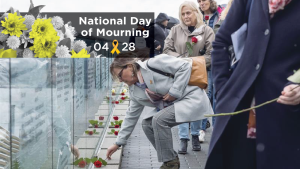Providing adequate COVID-19 protection in the workplace not only helps prevent transmission of the virus but it’s also linked to better mental health among workers, says Dr. Peter Smith, the lead author of a new study and senior scientist at the Institute for Work and Health (IWH).
The study found Canadian workers who were deemed essential and continued to work onsite in the spring of 2020 reported high levels of anxiety and depressive symptoms when they felt the coronavirus protection was inadequate.
“In particular, what we wanted to understand in this study was how the level of infection control procedures in the workplace and the adequacy of personal protective equipment (PPE) in the workplace are related to symptoms of anxiety and depression among workers and then comparing those experiences to people who work remotely and people who had lost their jobs,” explained Smith.
“The main finding of the study is the level of adequacy of protection of workers, how safe they feel in the workplace, is strongly associated with symptoms of anxiety and symptoms of depression.”
Labour Market Attachment, Workplace Infection Control Procedures and Mental Health: A Cross-Sectional Survey of Canadian Non-healthcare Workers during the COVID-19 Pandemic was one of two studies conducted by the IWH and the Occupational Health Clinics for Ontario Workers (OHCOW) at the start of the COVID-19 emergency. The other study by the same research team, published in the Canadian Journal of Psychiatry, focused on the experiences of nearly 6,000 health care workers.
“One of the things we wanted to specifically explore in this study is around what was the relationship between the level of protection people felt and the symptoms of anxiety and depression. I think there has been a lot of focus on the adequacy of PPE and infection control to prevent transmission of the virus and that’s appropriate, but there hasn’t been as much on understanding what are the other consequences are of having those infection control procedures in the workplace,” noted Smith.
Understanding the experiences of workers in essential sectors
The study, published in the Annals of Work Exposures and Health, was based on online surveys distributed by OHCOW through social media channels and labour networks from April to early June 2020 during the height of the first wave of the pandemic.
More than 3,500 Canadians who worked outside the health care sector such as construction, manufacturing, education, government and service sectors took part.
“We realized there are a lot of workers, we estimate 40 per cent of the Canadian labour market, has continued to work throughout the pandemic and construction is an example of an industry where it is not possible to do construction remotely,” said Smith. “It’s a sizeable industry group that has continued to be onsite throughout the COVID pandemic so it’s important not only to understand the experience of health care workers but also to understand the experiences of these other workers that are in essential industries that have continued to work during the pandemic.”
Survey says…
The study found of those who had infection control procedures being met, about 30 per cent had symptoms of anxiety and of the people who had none of those needs being met, 52 per cent had symptoms of anxiety.
Differences were observed between people who were working remotely, those who were in the workplace and those who had lost their jobs.
“We found people who were working remotely had fewer anxiety symptoms compared to those who were on the worksite. The highest were the ones that had lost their jobs,” said Smith. “However, when we started looking at the adequacy of infection control procedures and PPE among the people on the worksite, people who felt like they were completely protected in terms of they had all the infection control procedures being met, they had the lowest levels of anxiety, even lower than those working remotely. And the people with the highest levels of anxiety were those that were at the worksite who didn’t feel like they were being protected and they had anxiety symptoms that were higher than the people who had lost their jobs.”
Putting in place adequate systems and monitoring them is critical
The key takeaway is not only to understand the importance of effective infection control procedures and adequate supply of PPE along with putting those systems in place, but also monitoring them to make sure they are effective, Smith said.
“For people who have continued to work during the pandemic most of them want to feel safe at the workplace,” Smith pointed out.
“We always need to protect workers. Nobody wants to get injured or feel unsafe in the workplace. What the current pandemic has done is highlighted some of the challenges that workers face. For people who are still going to work, the majority of people in the construction industry, we do need to work on making sure those workers feel adequately protected when they are in the workplace.”
The study can be found by clicking here.
Follow the author on Twitter @DCN_Angela.











Recent Comments
comments for this post are closed